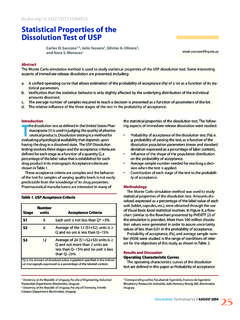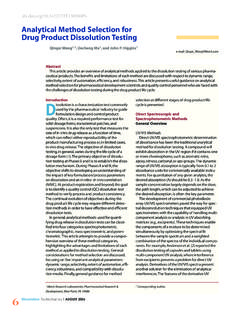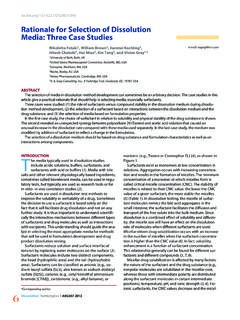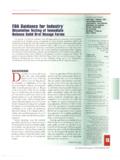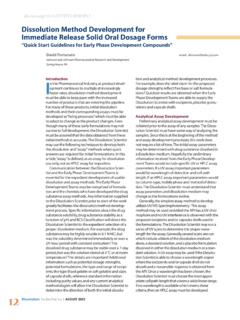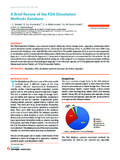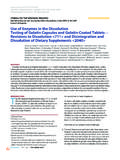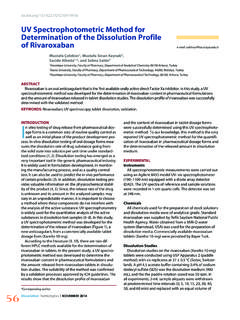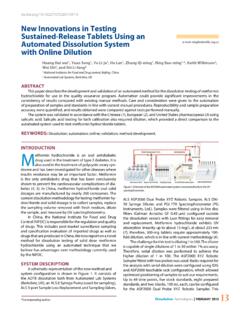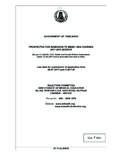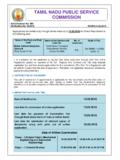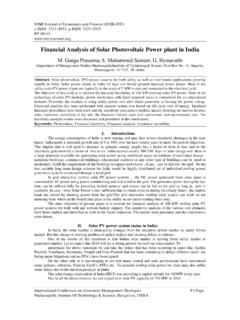Transcription of Dissolution Testing for Poorly Soluble Drugs: A Continuing ...
1 Dissolution Technologies | AUGUST 201024e-mail: Testing for Poorly Soluble Drugs: A Continuing PerspectiveK. Gowthamarajan1 and Sachin Kumar Singh2,*1 Department of Pharmaceutics, J. S. S. College of Pharmacy, post Box No. 20, Rocklands, Ooty-643001 dist. Nilgiris, tamilnadu , india 2 Department of Pharmaceutical Analysis, Bharathi College of Pharmacy, Bharathinagara-571422, Maddur Tq. Mandya Dist., Karnataka, IndiaABSTRACTThe development of a meaningful Dissolution procedure for drug products with limited water solubility has been a challenge to both the pharmaceutical industry and the agencies that regulate them. These challenges include developing and validating the test methods, ensuring that methods are appropriately discriminatory, and addressing the potential for an in vivo in vitro correlation (IVIVC).
2 Dissolution test media selection should be justified for pH (recommended pH range is ) as well as surfactant type (ionic versus non-ionic) and amount. If the drug is not Soluble in the in vivo pH range, with or without surfactants, then the use of nonaqueous media can be preferred with proper justifications. Physical modifications of the drug , such as particle size reduction, use of metastable polymorphs, eutectic mixtures, solid disper-sions, or complexation, are being widely used in the industry to enhance the drug Dissolution characteristics. In recent years, newer physical modifications ( , microemulsions and nanocrystals) are giving promising results in enhancement of drug Dissolution and bioavailability of Poorly Soluble drugs. Whatever method is used by the Dissolution scientists, it must aim towards the cheaper but most effective approach to enhance the Dissolution behavior of Poorly Soluble drugs.
3 *Corresponding Dissolution Testing is an analytical technique used to assess release profiles of drugs from pharmaceutical products, generally solid oral products such as tablets and capsules. For a dosage form to produce its effect, drug must be released and generally should be dissolved in the fluids of the gastrointestinal tract. drug Dissolution Testing plays an important role as a routine quality control test, for characterizing the quality of the product, for accepting product sameness under SUPAC (Scale-Up and post -Approval Changes) related changes, in waiving bioequivalence requirements for lower strengths of a dosage form, and in supporting waivers for other bioequivalence requirements (1). Dissolution from the dosage form involves mainly two steps: liberation of the drug from the formulation matrix (disintegration) followed by the Dissolution of the drug (solubilization of the drug particles) in the liquid medium.
4 The overall rate of Dissolution depends on the slower of these two steps. In the first step of Dissolution , the cohesive properties of the formulated drug play a key role. For solid dosage forms, these properties include disintegration and erosion. If the first step of Dissolution is rate-limiting, then the rate of Dissolution is considered disintegration controlled. In the second step of Dissolution ( , solubilization of drug particles), the physicochemical properties of the drug such as its chemical form ( , salt, free acid, free base) and physical form ( , amorphous or polymorph and primary particle size) play an important role. If this latter step is rate-limiting, then the rate of Dissolution is Dissolution controlled. This is the case for most Poorly Soluble compounds in immediate-release (IR) formulations whose solubility is less than 1 2 mg/L in the pH range of 2 8.
5 Recent advanced technologies like combinatorial chemistry and high-throughput screening are effective in the discovery of new drugs with good pharmacological activities (3). About 35 40% of the drugs discovered with these technologies have poor aqueous solubility (4). Dissolution Testing of Poorly Soluble compounds in immediate-release (IR) solid dosage forms poses many challenges. These challenges include developing and validating the test method, ensuring that the method is appropriately discriminatory, and addressing the potential for an in vivo in vitro relationship (IVIVR) or correlation (IVIVC). Satisfying all of these challenges and developing a meaningful Dissolution method is a large task, because the extent of release is too low ( , one cannot get 100% of the dosage form dissolved) and secondly, the rate of release is too slow ( , one cannot get Dissolution fast enough for a convenient test) (5).
6 Here, an attempt has been made to highlight the approaches to improve the Dissolution of Poorly Soluble improve the Dissolution of Poorly Soluble drugs, one needs to increase the maximum dissolvable dose in the Dissolution media. The maximum dissolvable dose of the drug is given byMaximum Dissolvable Dose = V CS / Sinkwhere V is the Dissolution medium volume, CS is the saturated solubility of the compound in the medium, and 248/23/2010 11:08:51 AM8/23/2010 11:08:51 Technologies | AUGUST 201025 Sink is sink condition calculated as CS/CD (where CD is the concentration of compound in the bulk medium) and should be greater than or equal to increase the maximum dissolvable dose, one needs to increase the Dissolution medium volume, change the medium to increase the saturation solubility of the compound, or reduce the Dissolution sink requirements.
7 There are several methods that are physiologically relevant that will increase the solubility of the drug in the medium. Alternatively, nonaqueous solvents can be used if justified. Therefore, the first step is to select a proper and justified medium for Dissolution Testing (5).Media Selection and Approaches to Improve the Saturation SolubilityThe choice of medium will depend on the purpose of the Dissolution test. The Dissolution characteristics of oral formulations should first be evaluated using test media within the physiologic pH range of ( for modified-release formulations) because low solubility drugs include those with adequate aqueous solubility at either acidic ( , amines) or neutral ( , organic acids) pH levels. During method development, it may be useful to measure the pH of the test medium before and after a run to see if the pH changes during the test (2).
8 For batch-to-batch quality Testing , selection of the Dissolution medium is based, in part, on the solubility data and the dose range of the drug product to ensure that sink conditions are met. Usually, USP Dissolution tests specify 900 mL of water or buffers as a Dissolution medium to provide sink conditions. The term sink condition is defined as a volume of medium at least three times the volume required to form a saturated solution of a drug substance. Some sources recommend five times and even ten times (5). However, how much is really needed? This question has yet to be justified. For Poorly Soluble drugs, finding appropriate sink conditions is challenging, particularly for drugs whose solubility is less than 2 mg/L. With regard to the sink condition, an alternative approach has been made by USP is the designing of flow-through cell apparatus (USP 4).
9 The flow-through apparatus (USP 4) allows flow rates exceeding 50 mL/min (3 L/hr). Although these volumes can provide the theoretical capacity for complete extent of Dissolution , for slowly dissolving compounds a limiting Dissolution rate can be reached. One then ends up merely diluting the sample concentration to a point at which it becomes difficult to detect analytically. Using reasonable flow rates and long assay times, this apparatus can provide a significant increase in the volume (5).As we mentioned above, intrinsic solubility of drug depends upon pH of medium, sink conditions as well as nature of the medium. For freely aqueous Soluble drugs and their immediate-release dosage forms, the use of water as a Dissolution medium is satisfactory. However, for drugs with limited aqueous solubility, the use of water as a Dissolution medium is as a Dissolution MediumDissolution Testing is used widely by the pharmaceutical industry and regulatory agencies to assure the continued quality of many oral dosage forms relative to the approved lot tested for bioavailability/bioequivalence (BA/BE).
10 Many USP Dissolution tests specify water as the Dissolution measured in water are not always indicative of solubilities in the gastrointestinal tract. The use of aqueous solubility to predict oral drug absorption can therefore lead to very pronounced underestimates of the oral bioavailability, particularly for drugs that are Poorly Soluble and lipophilic. Also, water lacks buffering capacity and thus, in some instances, the pH of the medium may change as the drug dissolves (as for salts). In addition, because water is not representative of the gastrointestinal environment, it is not considered a physiologically relevant medium (6).But in many USP monographs, water is still frequently used as a better Dissolution medium ( , Acarbose, Acetaminophen/Butalbital/Caffeine/Codein e Phosphate, Amoxicillin/Clavulanate Potassium, Aspirin/Meprobamate, Busulfan, Capecitabine, Carbamazepine, Cefadroxil, Cephalexin, Cetirizine HCl, Clonazepam, Cyclophosphamide, Dexmethylphenidate HCl, Desmopressin Acetate, Didanosine, Estazolam, Fenofibrate) (7).
